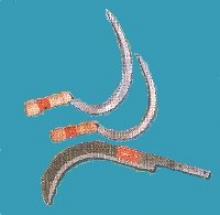Labour-saving technologies and practices: improved hand tools for harvesting cereals
The following includes features of hand tools for harvesting and advise the change from commonly used hand tools to best fitting ones. It also highlights the advantages which include labour saving, livelihood strengthening, equipment, skills, cost, risk and infrastructure. The disadvantages include the labour and skills required.
Description
Knives and sickles are the most common tools used for harvesting in Africa. There are typical work rates for harvesting cereals. For maize, this comprises 110 hours per ton per person (approximately 20 workdays per tonne). For sorghum/millet this is 210 hours per tonne per person (approximately 40 workdays per tonne). Working with a sickle is very slow but for crops like rice where the grains fall off easily, its use can minimize losses. Harvesting work rates are increased and labour inputs reduced when crops are planted in rows and when the crop is free of weeds.
1. Features of improved hand tools
1.1 Scythes
Harvesting wheat with a scythe rather than a sickle reduces the time required by a factor of three or four but requires considerable skills. Scythes can be fitted with a cradle attachment, allowing the cut crop to be collected at the end of each stroke and neatly stacked in rows, thereby reducing grain loss.
1.2 Reaping hooks
A compromise between a sickle and a scythe and easier to use than the scythe. The hook is used in the crouching position but, unlike the sickle, the sharp blade cuts the stems of the crop without having to hold them. Frequently used in conjunction with hooked sticks to gather in the crop.
2. Advantages
2.1 Labour saving
Using improved hand tools allows for labour to be quicker than traditional manual methods.
2.2 Livelihood strengthening
These tools are suitable for small farmers and for small plot sizes. The quality of the harvested crops is generally good and there are fewer losses compared to mechanised harvesting. They help to improve harvest yield and diminishes drudgery, therefore, livelihood resilience is benefited.
2.3 Equipment
Using this equipment, it is easy to harvest mature plants selectively when crops are not uniformly ripe.
2.4 Skills
A low skill level is required, except with scythes.
2.5 Cost
Minimal additional cost is needed to buy improved hand tools.
2.6 Risk
None.
2.7 Infrastructure
Hand tools are relatively easy to fabricate, maintain and repair.
3. Disadvantages
3.1 Labour
There are low work rates per labourer and high levels of drudgery.
3.2 Skills
The use of scythe requires skills and regular sharpening of the scythe blades is needed by special tools.
Figure 1. Sickles

©FAO/TECA
4. Related/associated technologies
- Conservation agriculture for smallholder farmers in dryland areas: ID 4676.
- Labour-saving technologies: integrated pest management: ID 7298.
- Labour-saving technologies: raised beds: ID 7299.
- Labour-saving technologies and practices: row planting, hand seeders and planters: ID 7301.
- Labour-saving technologies and practices: seeds and crops: ID 7302.
- Labour-saving technologies and practices: weed wipes and knapsack sprayers: ID 7303.
5. Objectives fulfilled by the project
5.1 Labour-saving technology (LST)
Labour is quicker than the use of traditional manual methods.
5.2 Pro-poor technology
The quality of the harvested crop is improved with fewer losses. With improved harvest yield, food security and income sources are increased.
